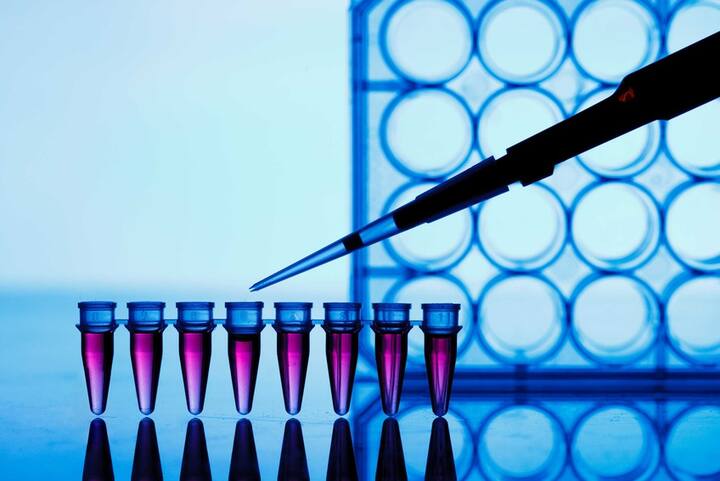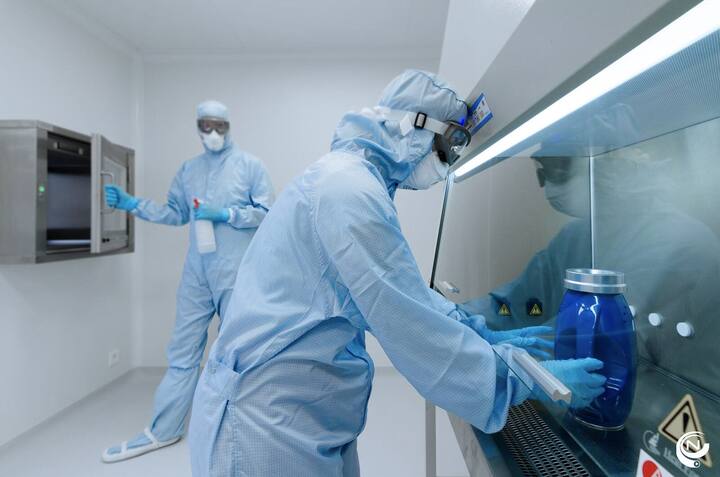
8 december 2022
A dive into the Oligo Project
A team of Normec Advipro colleagues is working on the Oligo Project at Janssen Pharmaceutica. The A-Team is happy to share how they got started and what their responsibilities were during the project. But what exactly is Oligo?
What is Oligo?
The expression of genetic material follows the path from DNA to RNA to proteins. Over the past century, drug development efforts have primarily focused on protein targeting through various types of compounds, including small molecules and monoclonal antibodies. In these cases, the drug modulates the activity of one or more specific proteins. However, not all protein types can be addressed using this classical approach.
An alternative strategy is to modulate DNA or RNA itself. This can be achieved using oligonucleotides. Oligonucleotides are short, single- or double-stranded synthetic nucleic acid polymers (≈20-mers) with a known sequence. When this sequence is complementary to a specific segment of DNA or RNA — referred to as an antisense oligonucleotide — it can form a duplex with that segment, thereby inhibiting gene expression. In this way, it affects the activity of the protein.
The oligonucleotide process consists of the following steps:
Synthesis: This is the chemical synthesis of relatively short fragments of nucleic acids with a defined chemical structure (sequence). To obtain the desired oligonucleotide, the building blocks (amidites) are sequentially coupled to the growing oligonucleotide chain in the exact order required for the final product. This synthesis takes place in a column packed with a solid support.
Cleavage & Deprotection: After the sequence has been completed, the product is cleaved from the solid phase (support), transferred into solution, deprotected, and collected.
Purification: The crude oligonucleotide solution is then purified from impurities using chromatography techniques.
Ultrafiltration / Diafiltration (UFDF): During this step, salts are removed from the oligonucleotide solution and the product is further concentrated.
Annealing (optional): In this optional step, single-stranded oligonucleotides can be converted into double-stranded forms through an annealing process.
Lyophilisation: Finally, excess water is removed through freeze-drying, resulting in the final oligonucleotide product.
Upgrade Oligonucleotides Center or Excellence
To be able to produce oligonucleotides suitable for toxicology batches or First-In-Human (FIH) clinical manufacturing, Janssen Pharmaceutica decided to upgrade its Oligonucleotides Center of Excellence and equip it with cGMP-compliant equipment. The aim of this Center is to expand internal capabilities and competencies to ensure the timely and reliable delivery of clinical products and to support the development of new manufacturing processes.
Fit For Purpose
Since the focus of this process is solely on FIH applications, it was decided to adopt a streamlined qualification strategy: the Fit For Purpose (F4P)approach. This approach emphasises maximising the leverage of FAT/SAT/commissioning tests, avoiding strict separation between qualification phases, and reducing QA reviews and approvals. As a result, qualification timelines are significantly shortened, and the amount of paperwork and documentation is greatly reduced.
Advipro’s Contribution
To successfully complete this large-scale project with its ambitious timelines, the support of Advipro was enlisted. The A-Team took responsibility for the compliance scope, covering equipment, utilities & facilities, as well as execution systems (CSV)
Lien - Equipment
My initial focus within the project was on the equipment scope. A large number of mobile vessels, reactors, skids, and more had to be purchased, tested, and qualified. I was responsible for:
Delivering all qualification documentation (URS/IA, protocols, reports, etc.). These were developed following the previously explained Fit For Purpose (F4P) approach. The biggest challenge was defining what should or shouldn’t be included within the F4P framework, as this was a new concept for everyone on the project team.
Drafting the overarching Change Control as well as various equipment-specific Change Controls. This also included coordinating, reviewing, and processing all associated CC actions — over 1,000 actions in total.
As the "last woman standing," it is now my responsibility to finalise the entire compliance scope for the Oligo Project — covering equipment, utilities & facilities, and execution systems.
Rani - Utilities & Facilities:
I started on the project by supporting Lien in drafting qualification documents based on the Fit For Purpose Equipment Testing approach. I attended several FATs in the Netherlands for the mobile vessels used in various steps of the oligonucleotide production process. My responsibilities included reviewing documentation and performing selected functional tests. After a brief period supporting the equipment scope, I shifted my focus entirely to the Utilities & Facilities scope of the project, which required a classical qualification approach. I was responsible for:
Drafting all qualification documents (URS, IA, qualification and safety protocols, qualification and safety reports, etc.), according to two different methodologies used by the two responsible departments within Janssen Pharmaceutica.
Preparing Utilities & Facilities-specific Change Controls.
Following up on and coordinating the delivery of evidence related to these CC actions.
This project also allowed me to sharpen my coordination skills, as I had to communicate with multiple contractors, as well as various internal departments within J&J.
Kristof - Execution Systems
As a compliance engineer, my main focus was on the automation aspect of the project. This role gave me hands-on experience with execution systems, PLCs, data integrity, and more.For the Oligo project, PCS7 was used — a process control system responsible for monitoring, visualisation, and, in certain cases, direct equipment control. PCS7 was involved in the change controls of many systems, which added a significant layer of complexity to the project. A full validation of PCS7 was required. I was involved from the design review phase all the way through to functional testing. My responsibilities were primarily related to documentation, including the drafting of the URS, Risk Assessment (RA), and IOQP. Additionally, I had the opportunity to personally execute a number of functional tests, particularly focusing on data integrity.
Sara - Project Manager
I was the first Advipro team member to step into the Oligo Project. I was actively involved in writing the Project Qualification Plan and in defining the compliance approach to be followed throughout the project. After the team was fully onboarded, I gradually transitioned my responsibilities to other team members. Within the project, I was responsible for the overall planning of compliance-related activities and the budget management for the entire Advipro A-Team. From the Advipro side, we continuously maintained a flexible mindset, providing the resources needed to support the project's evolving demands. Additionally, I monitored the team’s workload and stepped in wherever support was required.
And how did Janssen Pharmaceutica experience working with a top-tier A-Team?
“There was a genuine team spirit within Advipro, and they integrated seamlessly into the project team. It was an exciting journey in which the team flexibly deployed resources and ensured the timely delivery and aftercare of high-quality documentation. Project management was in excellent hands with this highly motivated team!”
- Jurgen Verbraeken, Senior Principal Engineer
More about Normec Advipro

Normec Advipro
Lille Belgium